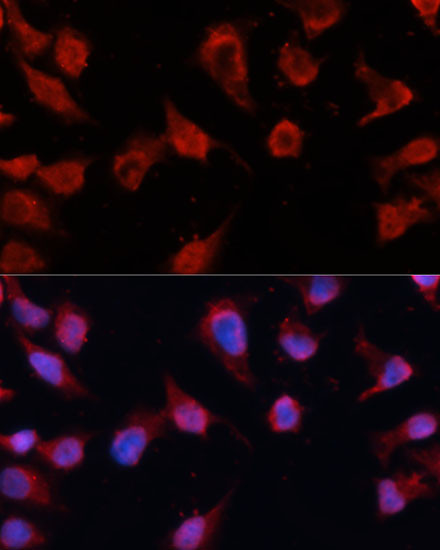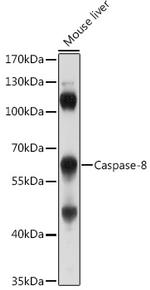Search Thermo Fisher Scientific
Product Details
PA5-120116
Species Reactivity
Host/Isotype
Class
Type
Immunogen
Conjugate
Form
Concentration
Purification
Storage buffer
Contains
Storage conditions
Shipping conditions
RRID
Product Specific Information
Positive test controls include: THP-1, Mouse liver. The target is usually found in the following locations: Cytoplasm.
Immunogen sequence: QSCLYAIAEE LGSEDLAALK FLCLDYIPHK KQETIEDAQK LFLRLREKGM LEEGNLSFLK ELLFHISRWD LLVNFLDCNR EEMVRELRDP DNAQISPYRV MLFKLSEEVS ELELRSFKFL LNNEIPKCKL EDDLSLLEIF VEMEKRTMLA ENNLETLKSI CDQVNKSLLG KIEDYERSST ERRMSLEGRE ELPPSVLDEM SLKMAELCDS PREQDSESRT SDKVYQMKNK PRGYCLIINN HDFSKAREDI TQLRKMKDRK GTDCDKEALS KTFKELHFEI VSYDDCTANE IHEILEGYQS ADHKNKDCFI CCILSHGDKG VVYGTDGKEA SIYDLTSYFT GSKCPSLSGK PKIFFIQACQ GSNFQKGVPD EAGFEQQNHT LEVDSSSHKN YIPDEADFLL GMATVKNCVS YRDPVNGTWY IQSLCQSLRE RCPQGDDILS ILTGVNYDVS NKDDRRNKGK QMPQPTFTLR KKLFFPP
Target Information
Caspase 8 (CASP8) is a member of the cysteine-aspartic acid protease (caspase) family. Sequential activation of caspases play a central role in the execution-phase of cell apoptosis. Caspases exist as inactive proenzymes composed of a pro-domain, a large protease subunit, and a small protease subunit. Activation of caspases requires proteolytic processing at conserved internal aspartic residues to generate a heterodimeric enzyme consisting of the large and small subunits. Caspase 8 is involved in the programmed cell death induced by Fas and various apoptotic stimuli. The N-terminal FADD-like death effector domain of Caspase 8 suggests that it may interact with Fas-interacting protein FADD. Caspase 8 was detected in the insoluble fraction of the affected brain region from Huntington disease patients but not in those from normal controls, which implicated the role in neurodegenerative diseases. Caspase 8 binds to the death effector domain (DED) of FADD through an analogous DED domain present in tandem in the pro-form of the Caspase 8 protein. Activated Caspase 8 then activates other downstream caspases including Caspase 9, thereby committing the cell to undergo apoptosis. In addition, Caspase 8 also reacts with Jurkat cells and Tonsil. Overexpression of Caspase 8 induces apoptosis, which can be blocked by inhibitors specific for the ICE family. Many alternatively spliced transcript variants encoding different isoforms have been described for Caspase 8, however, not all variants have had their full-length sequences determined.
For Research Use Only. Not for use in diagnostic procedures. Not for resale without express authorization.
References (0)
Bioinformatics
Protein Aliases: Apoptotic cysteine protease; Apoptotic protease Mch-5; CAP4; CASP-8; caspase 8, apoptosis-related cysteine peptidase; caspase 8, apoptosis-related cysteine protease; Caspase-8; Caspase-8 precursor; Caspase8; EC 3.4.22.61; FADD-homologous ICE/CED-3-like protease; FADD-like ICE; Fas-linked ICE-like protease; FLICE; FLJ17672; ICE-like apoptotic protease 5; ICE8; MACH; MACH-alpha-1/2/3 protein; MACH-beta-1/2/3/4 protein; MGC78473; MORT1-associated ced-3 homolog; OTTHUMP00000163720; OTTHUMP00000165063; OTTHUMP00000206557; OTTHUMP00000206581
Gene Aliases: ALPS2B; CAP4; CASP-8; CASP8; FLICE; MACH; MCH5
UniProt ID: (Human) Q14790, (Mouse) O89110
Entrez Gene ID: (Human) 841, (Mouse) 12370

Performance Guarantee
If an Invitrogen™ antibody doesn't perform as described on our website or datasheet,we'll replace the product at no cost to you, or provide you with a credit for a future purchase.*
Learn more
We're here to help
Get expert recommendations for common problems or connect directly with an on staff expert for technical assistance related to applications, equipment and general product use.
Contact tech support



